Scientific ‘fingerology’ may help you to identify your potential for success… or failure!
October 16, 2012
 Scientific ‘fingerology’ may help you to identifiy your most likely potential for success… or failure via the ratio of only two fingers. What is your 2D:4D digit ratio?
Scientific ‘fingerology’ may help you to identifiy your most likely potential for success… or failure via the ratio of only two fingers. What is your 2D:4D digit ratio?
More blogging-reports are available at:
The Finger length & Digit Ratio blog
PS. Your digit ratio can be seen as a measure for prenatal testosterone, which explains why this finger-measure correlates with many aspects in life!

Last summer professor John T. Manning re-designed his popular 2D:4D digit ratio theory about finger length ratio development in the hand. While he had already mentioned the role of prenatal sex steroids, now the updated theory now focusses on the balance between sexe hormones (androgens) testosterone & oestrogen during the development in the whomb!
Professor Manning presented his revised theory in the PNAS magazine under the title: ‘Resolving the role of prenatal sex steroids in the development of digit ratio‘.
Manning’s new working hypothesis now includes e.g. the following 7 key-elements:
1 – The 2D:4D digit ratio results from the balance between prental androgens testosterone & estrogen;
2 – A high 2D:4D digit ratio results from relatively low testosterone concentrations – OR relatively high estrogen concentrations;
3 – A low 2D:4D digit ratio results from relatively high testosterone concentrations – OR relatively low estrogen concentrations;
4 – The ring finger (= digit 4D) is featured with many more hormone receptors compared to the index finger (- digit 2D), therefore the 2D:4D digit ratio is mostly driven by changes in the length of the ring finger (due to prenatal hormone concentrations);
5 – Studies in human & animals indicate that the link between prenatal androgens and 2D:4D digit ratio is generally stronger for the right hand;
6 – 2D:4D Digit ratio varies with sexe: males generally have longer fourth digits relative to second digits than females;
7 – 2D:4D Digit ratio varies with ethnicity.
A quote from Manning’s article:
“Armed with this list of skeletogenic genes linked to 2D:4D, we can now be more focused in our examination of the links between 2D:4D and the etiology of sexdependent behaviors and diseases of the immune system, cardiovascular disorders, and a number of cancers.”
“Prenatal sex steroids [i.e., prenatal testosterone (PT), prenatal estrogen (PE)] are often implicated in the etiology of behaviors and diseases. They show sex differences (higher concentrations of PT to PE in males), with PT peaking at the end of the first trimester, and cause permanent “organizational” changes in the brain and other organ systems. It has een suggested that relative levels of PT and PE may have differential effects on fertility, speed, strength, aggression, autism, many cancers, and heart disease.”
Full report:
Professor John Manning revised his 2D:4D finger ratio theory
Can’t Read Minds? Your Hands May Tell Why!
September 6, 2011

Wearing your heart on your sleeve is merely an adage, but most people do display their emotions – even if unintentionally – on their faces. Women tend to be better than men at reading other people’s subtle facial cues, especially cues from the eyes. Because of the gender difference in cognitive empathy – the ability to notice and correctly interpret body language – psychobiologistsscientists that study psychology from a biological perspective, or vice versa have hypothesized that testosterone – a sex hormone present in much higher levels in males versus females levels – could play a role in “mind reading” ability, or lack thereof.
A new study in PNASProceedings of the National Academy of Sciences validates this hypothesis by demonstrating that a dose of testosterone can make women lose some of their cognitive empathy. Researchers recruited 16 young women (age 20-25) to participate in their study. The women were given either a testosterone pill or a placebo, and then tested on their ability to assess emotions based on photographs of eyes. The test the women took is called the Adult Eyes Test, and is available for free from the Autism Research Center at the University of Cambridge. Here’s a sample question (formatting is slightly modified):

For the correct answer, click here.
Each woman was tested twice – once with placebo and once with real testosterone (in random order; they didn’t have any idea which was which). 75% of the women performed worse on the “mind reading” test after taking testosterone than after taking a placebo. So to a first approximation, an artificial increase in testosterone levels impaired women’s abilities to interpret facial expressions.
But the results aren’t quite that simple. Some women were less affected by the extra testosterone than others, and the researchers had a hunch that this could relate to their exposure to testosterone in the womb. All fetuses are exposed to testosterone while developing, but to different extents. There is a simple way to qualitatively measure fetal testosterone exposure – this parameter is believed to be correlated to the adult ratio of ring finger length to index finger length (see picture at the top of this post).
Larger ratios of ring finger to index finger lengths correspond to higher fetal testosterone levels. This study showed no difference between the inherent expression-reading ability of women exposed to higher vs. lower doses of testosterone in the womb. However, the women with longer ring fingers (higher fetal testosterone) seemed to be more easily impaired when given a dose of testosterone in pill form.
Thus, this study demonstrated that (1) testosterone administered to women can impair their ability to read facial expressions, and (2) women who experienced more testosterone in the womb are more sensitive to the effects of testosterone administered as adults. Nothing further can be definitively gathered from these results, but they seem to suggest that men’s testosterone levels could be to blame for their increased confusion about what others (especially women!) are thinking/feeling.
PS. A brand new study reported by researchers from Florida has recently (sep 2011) presented proof that fingers have hormonal receptors!
Via: ICanHasScience
The following finger length study presents a likewise effect:
How lingerie can sharpen the financial mind!

The Extra Thumb in the Mole & the Giant Panda is not a real finger: it’s a Sesamoid Bone!
July 16, 2011

A mole has (only) 5 digits + a large sickle shaped sesamoid bone.
Vertebrates usually have five fingers on each hand, but in some specifies – including the Great Panda & the Mole – the hand ‘appears’ to be featured with an extra thumb (polydactly). Earlier this week paleontologists from the University of Zurich have uncovered a new theory about the underlying biological causes that are responsible for the mole’s extra thumb.
The researchers see a connection between the species-specific formation of the extra thumb in the mole and the peculiar “male” genital apparatus of female moles. In many mole species, the females have masculinized genitals and so-called “ovotestes,” i.e. gonads with testicular and ovary tissue instead of normal ovaries. Androgenic steroids are known to influence bone growth, transformation and changes, as well as the transformation of tendons in joints. A high level of maternal testosterone is also thought to be one of the causes of polydactyly in humans.
ABOUT SESAMOID BONES & EXTRA THUMBS!
Anatomically, what ‘appears’ to be extra thumb that is seen in the Mole and the Giant Panda can be described as the result of excessive growth of the so-called sesamoid bones which are typically found in all vertebrates at the end of the thumb metacarpal.
NOTICE: Sesamoid bones are found in locations where a tendon passes over a joint.
In the human hand sesamoid bones are rather small and they act to protect the tendon and to increase its mechanical effect – so they play a key role in the multi-functionality of the human hand, see the picture below.

– Sesamoid bones in the human hand –
However, in some other vertebrate species sesamoid bones have a more explicite function for it’s owner.
E.g. in the mole’s paw the extra thumb is shaped by a sesamoid bone manifesting as a sickle shape which gives the mole a bigger surface for digging.
And in the Giant Panda’s paw the extra thumb is actually shaped by a radial sesamoid larger than the same bone in counterparts such as bears. It is primarily a bony support for the pad above it, allowing the panda’s other digits to grasp bamboo while eating it.

The Giant Panda has 5 digits + a large sesamoid bone.
NOT A REAL FINGER!
These considerations implicate that Moles and Giant Pandas do not really have an extra finger. This is confirmed by the fact that their ‘appearance’ of an extra finger is not featured with other typical characteristics seen in the other fingers – e.g. a nail (claw) & phalanges are missing, and embryology studies have revealed that the extraordinary sesamoid bone in both the Mole and the Panda starts developming at a much later stage compared to the 5 digits that are typically seen in every vertebrate!
MORE ABOUT THE HANDS IN VERTEBRATES:
• The mystery of the five fingers
FINGER LENGTH – A reliable predictor for prostate cancer?
December 29, 2010
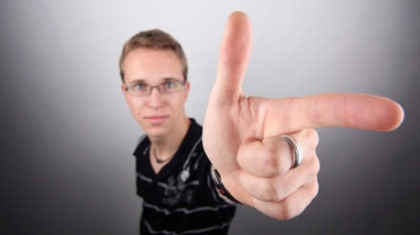 Earlier this month, British researchers published new research presenting a link between the relative length of the index finger and the risk of developing prostate cancer. In men with an index finger longer than the ring finger the chances are 33% higher for not developing the disease.
Earlier this month, British researchers published new research presenting a link between the relative length of the index finger and the risk of developing prostate cancer. In men with an index finger longer than the ring finger the chances are 33% higher for not developing the disease.
Often such studies are qualified by non-experts as “nonsense” – initially because of the association with classical palmistry. Usually a main argument of concern is the seize of the studied sample: many ‘2D:4D digit ratio’ studies have been focused relatively small samples, and usually with the statistics were simly not strong enough to be applied to individuals. But those arguments can not be used to the describe the new British study!
The new British research involves a study where the hands of 1,524 prostate cancer patients were examined, which were compared with a control group of 3,044 men.
It can also be noted that Professor John Manning described in his second book ‘The Finger Book‘ with great details the suspected link between the ‘2D:4D digit ratio’ and prostate cancer – a complex theory about of role glutamine chains in the sensitivity of hormone receptors, which in their turn play a role in the activation of testosterone in the body:
“…The various forms of the androgen receptor have important consequences for our health and behaviour. For example, African-American men have shorter glutamine chains (high sensitivity to testosterone) than white men. Short glutamine chains are associated with an increased susceptibility to prostate cancer, and this may in part explain why the incidence of prostate cancer is higher in African-Americans than in white Americans. …”
In short, there seems to exist a triangular relationship between: 1) the high percentage of prostate cancer in Americans with African ancestry, 2) the length of the glutamine chains, and 3) the length ratio between index finger and ring finger.
The importance of the new British study can be recognized in the fact the use of preventive screening for prostate cancer – which is anno 2010 usually done through the use of a blood test – is still an object of confusion. Simply because the benefits of the screening devices are still very unclear. Meanwhile it is a fact that prostate cancer is known as the No. 1 cause of death from cancer in men (see picture below).
The British researchers therefore are speculating about how to add a practical application of their finger length study to the traditional methods of prostate cancer prevention screening!
RELATED SOURCES:
• More finger length studies
• How to read your own palm!
Researchers presented earlier today new evidence that neanderthals were more competitive & promiscuous than we are today! Maybe more surprizing is the method which the researchers used to acquire their new findings: via finger length measurements!
The study, published in the Proceedings of the Royal Society B, draws upon a famous and controversial indicator of social behavior: the comparative length of the index finger and the ring finger, also known as the 2D:4D finger ratio. If the ring finger is longer than the index finger, that’s supposed to be correlated with higher prenatal exposure to androgens — resulting in a higher proclivity for aggressiveness and promiscuity.
Scientists, in collaboration with researchers at the universities of Southampton and Calgary, used finger ratios from fossilised skeletal remains of early apes and extinct hominins, as indicators of the levels of exposure species had to prenatal androgens – a group of hormones that is important in the development of masculine characteristics such as aggression and promiscuity.

It is thought that androgens, such as testosterone, affect finger length during development in the womb. High levels of the hormones increase the length of the fourth finger in comparison to the second finger, resulting in a low index to ring finger ratio (2D:4D digit ratio). Researchers analysed the fossil finger bone ratios of Neanderthals and early apes, as well as hominins, Ardipithecus ramidus and Australopithecus afarensis, to further understanding of their social behaviour.

The hand bones of an early hominid

The hand bones of a neanderthal
The team found that the fossil finger ratios of Neanderthals, and early members of the human species, were lower than most living humans, which suggests that they had been exposed to high levels of prenatal androgens. This indicates that early humans were likely to be more competitive and promiscuous than people today.
The results also suggest that early hominin, Australopithecus – dating from approximately three to four million years ago – was likely to be monogamous, whereas the earlier Ardipithecus appears to have been highly promiscuous and more similar to living great apes. The research suggests that more fossils are needed to fully understand the social behaviour of these two groups.
Dr Susanne Shultz, from the Institute of Cognitive and Evolutionary Anthropology at the University of Oxford describes:
“Social behaviours are notoriously difficult to identify in the fossil record. Developing novel approaches, such as finger ratios, can help inform the current debate surrounding the social systems of the earliest human ancestors.”
And Dr Emma Nelson, an archaeologist from the University of Liverpool, argues that comparing the finger-length ratios of extinct and present-day species is a valid technique for making an indirect assessment of our long-gone ancestors’ social behavior. She said:
“It is believed that prenatal androgens (male sex hormones) affect the genes responsible for the development of the fingers, toes and the reproductive system. We have recently shown that promiscuous primate species have low index to ring finger ratios, while monogamous species have high ratios.”
“We used this information to estimate the social behaviour of extinct apes and hominins. Although the fossil record is limited for this period, and more fossils are needed to confirm our findings, this method could prove to be an exciting new way of understanding how our social behaviour has evolved.
READ MORE ABOUT EARLIER RESULTS:
• Primate finger length linked with social behavior
• Human finger length & sexual orientation
• Evolution of the human hand & palmar creases
Will Your Man Cheat …?
[tweetmeme source=”handresearch” only_single=false] What if you could find out if your man is at a higher risk for infidelity before you married him? Dr. Phil and his panel of medical experts discuss the new science behind a cheater’s brain and what can be done if your loved one is at a higher risk. Author of Change Your Brain, Change Your Body, Dr. Daniel Amen, author of Insatiable Wives, clinical psychologist Dr. David Ley, Claremont University’s Dr. Paul Zak and author of The Male Brain, neuro-psychiatrist Dr. Louann Brizendine explain how you can discern a man’s risk for infidelity and the treatment options to lower his risk.
Dr.Phil.com presents a 4 item list of physiological indicators that your han is at a higher risk for cheating:
-
Length of ring finger compared to pointer finger: The length of a man’s ring finger is linked to testosterone in utero and during puberty. A longer ring finger means more testosterone, and the increased likelihood of a greater number of sex partners and a higher risk of cheating.
- Facial symmetry and size of jaw: If one side of a man’s face matches the other side, is symmetrical, the more it is an indicator to women that that man has high genetic value. Men whose faces are more [symmetrical] are more likely to have more partners because more women want to have their children.
- Size of penis: If a male is well-endowed, that means more testosterone and a higher risk of cheating.
- Brain injuries: Men with a history of engaging in impact sports like football or martial arts, or men who’ve had a history of concussions are at a higher risk. Also, men with disorders like ADD or bipolar disorder have low pre-frontal cortex activity or hyper-frontal activity, which could mean less ability to stop impulsive behaviors, like cheating.
By the way, did you know that… Casanova had the long ring finger!
SUGGESTION FOR FURTHER READING:
• BBC Test: finger length & sex I.D.!
• Finger length & Cupid’s science!
• The science of gaydar: finger length & sexual preference!
• What they say about men with long ring fingers!


Last year NextNature reported that job interviews might get replaced by brain scans within five years. But our bodies presents another biometric measure that correlates with social ability – it’s in the ratio of your fingers! John T. Manning, professor in psychology, has demonstrated how his ‘controversial’ academic theory can be applied to individuals. Academic science has developed a new theory about how finger length relates to human biology & behavior. A significant part of theory is focussed on the so-called: ‘2D:4D digit ratio’, which concerns the full length ratio of only two fingers: index finger vs. ring finger. In women the length of both fingers is usuallly about equal (2D:4D digit ratio = 1.00), while in men the ring finger is usually slightly longer (digit ratio = 0.98): a tiny sex difference. NOTICE: This tiny sexe difference has been confirmed among many ethnic populations around the world, but one should also keep in mind that the finger length differences between ethnic populations are often larger than the finger length differences between males and females. FINGER LENGTH & SOCIAL ABILITY The earlier NextNature report described that brain scans can recognize tendencies towards autism – it concerns a matter of ‘hypermasculinity’ of the brains. The same is true for the ‘2D:4D digit ratio’: multiple international studies have revealed that people with autism usually have typical male-like finger length ratios (0.94 or lower). However – maybe less surprizing – the typical male-like low 2D:4D ratio also relates to athletic ability! FINGER LENGTH & ATHLETIC ABILITY Professor John T. Manning of the University of Liverpool (School of Biological Sciences, Liverpool, UK) explains the link between finger length & athletic ability as follows (in the BBC’s ‘Secret of The Sexes‘): “Our fingers have information about how much testosterone and how much oestrogen we’ve been exposed to in the whomb. So, the longer one’s ring finger relative to one’s index finger, the more testosterone you’ve had. And that testosterone has an effect on the brain, and on the body. If a boy has a large amount of testosterone before birth, he is likely to be born with a very efficient heart and vascular system.” “So the longer one’s ring finger relative to one’s index finger, the faster one can run.” The BBC’s “Secret of The Sexes” confronted the ‘finger Professor’ with six athletes – all 5000 meter specialists, and asked him to “predict” the outcome of the race based on finger length only. Actually, the BBC provided Manning photocopies of the athletes hands, and in return Professor Manning risked his reputation by providing the results of a race that had yet to be run. The outcome of the experiment is unvealed “LIVE” in the video. And surprizingly… the theory appeared to be pretty accurate in practice. After Manning & the athletes are controfonted with the results Manning summarizes: “… We’ve got four out of six right, but the two that are wrong were kind a quite close.” The winner of the 5000 meter race responds: “I thought… that finger thing is bullox because there are so many variables… I am very impressed”. Coincidence? Manning’s theory was also confirmed by the results of various studies e.g. on endurance running & sprinting speed. And in another likewise experiment finger length correctly predicted the outcome of a 100 meters race with 5 young sprinters. FINGER LENGTH & OTHER LIFE ISSUES In his second book – titled ‘The Finger Book‘ – Professor Manning explains that because of the prental link with the androgens (testosterone & oestrogen), finger length studies have generally shown consequent sensible correlations with a rainbow of life issue. The tiny sex difference appears to be highly revealing, for hundreds of studies the ‘2D:4D digit ratio’ appears to correlate with a wide range of topics that are usually also known for a typical male-female difference, including: musical ability, personality, health, and even sexual preference. More articles & reports are available at: finger length & digit ratio news. The following three videos present more materials from the episode ‘Brain Sex’ of the BBC’s “Secrets of The Sexes” – that relate to finger length – including social ability: in the second and third video Manning explains how finger length is related to in respective: performance in spatial-visual tasks and another typical sexe-related aspect of personality: the ability to empathize! NOTICE: You can see the complete movie (three episodes) at: CORNEL1801. HOW TO MEASURE DIGIT RATIO? NOTICE: Measuring the ‘2D:4D digit ratio’ is really a matter of measuring the full length of both fingers. Two additional tips to avoid: 1 – don’t try to ‘judge’ the 2D:4D digit ratio with bare eyes only (conscientious measurment + calculation is a necessity) 2 – one can not find the ‘2D:4D digit ratio’ from the back of the hand, nor the tips of the fingers only. Source picture: University of Cambridge. IS THIS THE NEW ‘PALM READING’? In 2008 Professor Chris McManus of the University College London (Psychology and Medical Education) characterized Manning’s finger research as follows: “Chiromancy, the notorious pseudoscience that Sir Walter Scott bracketed with physiognomy, astrology and “other fantastic arts of prediction”, has for two decades been creeping back into scientific favour. And John Manning is its high priest. In The Finger Book, he [Manning] writes: “I believe that the pattern and nature of our decline in middle life and the disease which will eventually lead to our death, is dependent to a large extent on our experiences as a foetus”, a phrase that could almost have been written by Cheiro, the early 20th-century society palmist.” Because of the obvious association with the divination aspect of palmistry (which is still very popular in various countries such as India & Pakistan), the issue of the ‘2D:4D digit ratio’ will probably continue to have a controversial status. More ‘Next Nature’ reports? – See: www.nextnature.net. |
|
How reliable is finger length in issues of athletic ability? Another experiment with five athletes: all 100 meters specialists… the outcome is again rather remarkable! VIDEO SUMMARY (TRANSLATED): This video – broadcasted in Spanish language – includes e.g. scenes from Discovery Channel. Professor John T. Manning explains how finger length is related to athletic ability. Finger length ratios are established in utero under the influence of testosterone. Testosterone plays an important role in the early development of the heart and lungs – the ‘motor’ of every athlete! But it is very hard to say how much in utero testosterone is involved in the early development of individuals. However, the 2D:4D finger length provides an indication for the amount of in utero testosterone. In the second half of this video Mannings describes that the five athletes all must have had large amounts of testosterone during their early development in the whomb – because their ‘2D:4D finger ratio’ is rather low (for males). But in only one athlete the ‘2D:4D finger ratio’ is exceptionally low – and Manning explains why he expects that this athlete (no.5) has the best chance to win the race. Then the moment of truth arrives… the athletes are prepairing to start the race. Who will win? The movie shows clearly that athlete no.5 was by far able to make the fastest start… during the race athlete no.2 becomes very competing… but at the finish athlete no.5 is still ahead, and wins the race. Manning made the right prediction! At the end of the video Manning explains his prediction again, but he also points out that the proceses in the womb do not explain everything. Feel free to watch the video again – knowing the succesfull outcome of the experiment should make you enjoy watching this video, and it should be easy to remember the outcome again!!! SUGGESTION FOR FURTHER READING: How to measure the ‘digit ratio’? (= 2D:4D finger ratio) – Measure from the crease at the base of the finger to the tip. Divide the number from the index finger (2D) and divide it by the number from the ring finger (4D). |
Fingers of fate – how to measure your ‘2D:4D finger ratio’?
October 1, 2009

The average ‘digit ratio’ is 0.98 among women (while 0.96 among men). OK, you heard about those finger stories, but do you know how to measure your ‘digit ratio’? Professor John T. Manning’s “digit ratio” – refers to the ratio between the length of your index finger and your ring finger. The following describes the basic findings of this ‘scientific’ finger research + a 3-step method on how to measure your ‘digit ratio’! Studies have found that during gestation, testosterone has powerful effects on the developing body and brain, and can cause increased confidence, (financial) risk preferences and search persistence, as well as heightened vigiance and quickened reaction times. The most common measure is the ratio of the index to ring finger (2D:4D) on the right hand. A relatively longer ring finger – lower 2D:4D – indicates higher prenatal testosterone levels. Men typically have scores below 1, women above 1. HOW TO MEASURE YOUR ‘DIGIT RATIO’? 1. Place your right hand firmly on the plate of a photocopier with fingers straight. Close cover of place a sheet of paper over your hand to prevent glare from overhead lights. Ensure that the bottom crease and finger tip can be clearly seen in the photocopy. 2. Use a ruler of calipers to measure the distance from the middle of the bottom crease to the tip of the finger. 3. Once you have the measures for both your ring and index finger, then divide the length of your index finger by the length of your ring finger. The result is 2D:4D (2nd digit divided by 4th digit). Source: University of Cambridge.
SUGGESTIONS FOR FURTHER READING: • Second to fourth digit ratio, testosterone and perceived male dominance! |




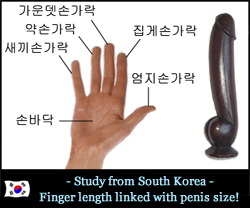 Finger length & penis size linked!
Finger length & penis size linked!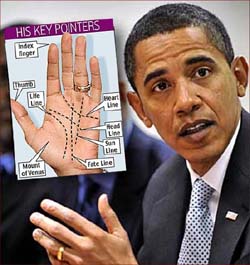 The hands of Barack Obama
The hands of Barack Obama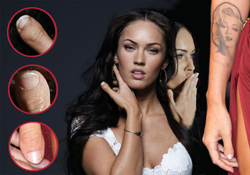 Megan Fox thumbs – TRIBUTE
Megan Fox thumbs – TRIBUTE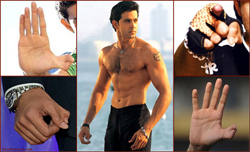 Hrithik Roshan thumbs – TRIBUTE
Hrithik Roshan thumbs – TRIBUTE Hand Reading Research!
Hand Reading Research! MultiPerspective Palm Reading
MultiPerspective Palm Reading